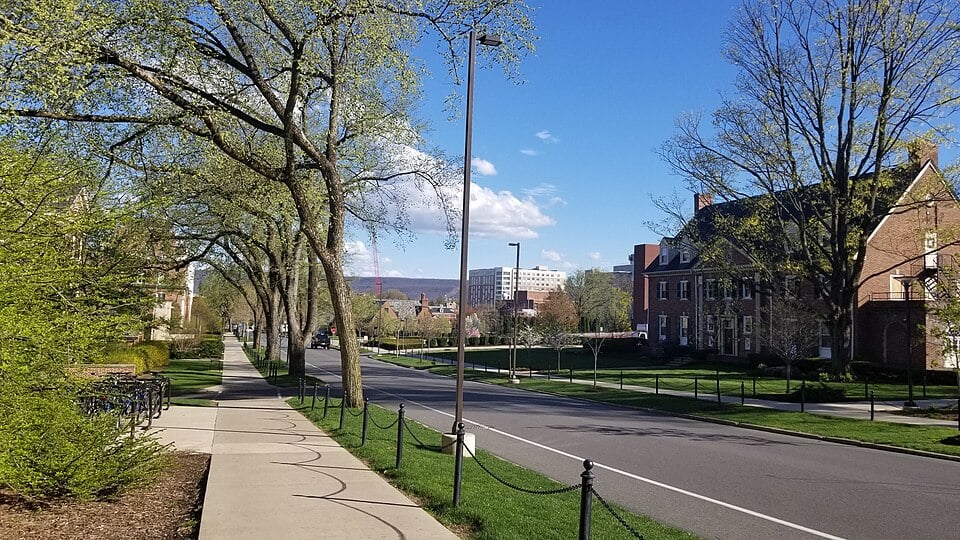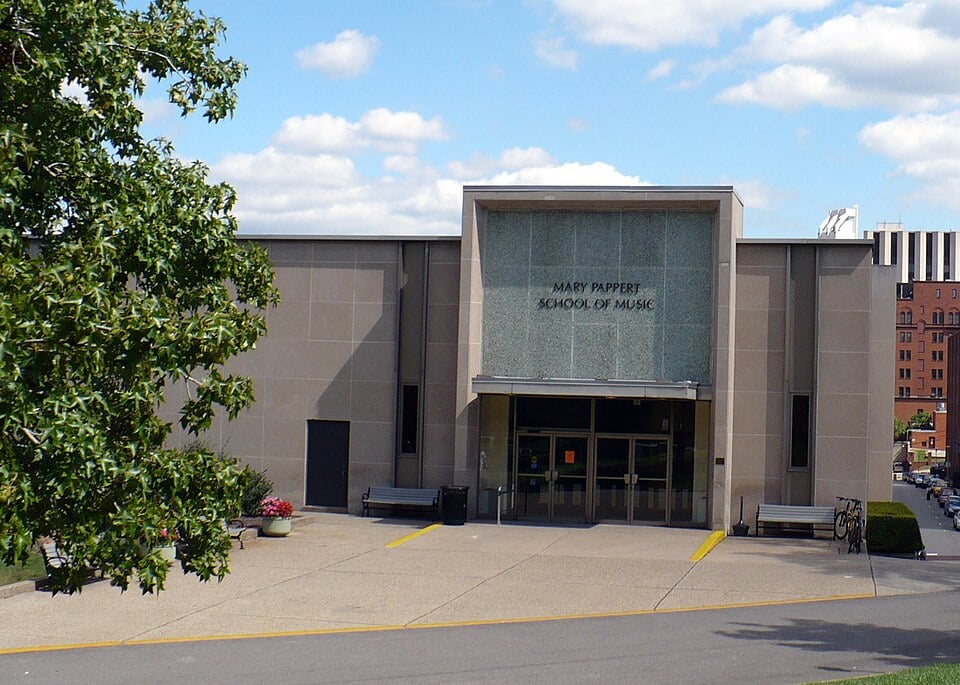New York City. Los Angeles. Ask any aspiring musician where they hope to study and work, and surely these two cities will come up.
While the answer certainly stems, in part, from the mythology and romance built up around these two coastal poles, it’s just as likely that the aspiring musician is just listing the only two American cities they’ve heard of, at least when it comes to a career in music.
That’s too bad because, as lovely as NYC and LA undoubtedly are, they hardly hold a monopoly on excellent music locations. In fact, Pennsylvania, a state most often associated with steel mills and championship sports teams, has a long history of cultivating the arts. Nowhere is that more clear than in the Keystone State’s excellent music schools.
Each of the seven schools on this list offers everything a budding musician needs to become a professional. They all have incredible facilities, studios, and stages where learners can hone their craft.
Each boasts departments filled with first-rate musicians, working professionals who can bring their expertise to the next generation.
Most importantly of all, each school has access to audiences, listeners ready to hear students follow in the footsteps of masters or put their own spin on a time-honored genre.
These seven schools prove that you don’t have to go to the biggest cities on the planet to get a world-class musical education.
Carnegie Mellon University School of Music

Carnegie Mellon University traces its roots to the Carnegie Technical Schools, founded in 1900 by industrialist Andrew Carnegie as a project to educate the people of Pennsylvania.
The schools took their mandate seriously and, when it expanded to become the Carnegie Institute of Technology in 1912, added the Carnegie Mellon University School of Music.
Carnegie Mellon Music offers unique majors such as the Integrative Design, Arts, and Technology (IDeATe) program. Through IDeATe, musicians collaborate with students in the hard sciences, finding new ways of integrating technology into musical expression.
However, in its traditional performance program, Carnegie Mellon benefits significantly from the nearby Pittsburgh Symphony, which is among the top orchestras in the United States. In fact, many of the Pittsburgh Symphony members teach at Carnegie Mellon as professors!
Carnegie Mellon Music only accepts 30% of its applicants each year, making it one of the more competitive schools on this list.
Penn State University School of Music

The School of Music at Penn State offers students the best of both worlds.
As an R1 research university and a land-grant state school, Penn State is at once accessible to a wide range of students and also a home for cutting-edge research and experimentation. For those in Penn State’s School of Music, that combination means that students can immerse themselves within a diverse student body while still enjoying access to incredible teachers.
Faculty members at Penn State Music include accomplished musicians like Tonya Mitchell-Spradlin, director of Wind Band Studies and conductor of the Symphonic Wind Ensemble. Before coming to Penn State, Mitchell-Spradlin served as director of bands at the University of South Carolina and a clinician for the President’s Own Marine Band Conductor Training Program.
Students can watch and perform in one of the school’s many outstanding venues. The premiere performance venue at Penn State Music is Eisenhower Auditorium, a 2,500-seat area used by the Nittany Valley Symphony and other high-profile groups.
Since its opening in 1974, Eisenhower Auditorium has hosted the Pittsburgh Symphony Orchestra, Yo Yo Ma, Wynton Marsalis, Billy Joel, and many other musical luminaries.
Gettysburg College Sunderman Conservatory of Music

Most of the schools on this list can trace their roots back 100 years or more. Sunderman, however, is a much more recent institution.
Gettysburg College, an excellent liberal arts school established in 1832, founded Sunderman in 2006, expressly for the purpose of meeting the challenges of the new century.
Thus, Sunderman certainly has the traditional aspects anyone would expect to find at a respectable institution. That includes performance opportunities with the Gettysburg College Symphony Orchestra, the Jazz Ensemble, and multiple vocal groups.
However, Sunderman also has innovative classes and programs that you won’t find anywhere else.
For example, students can take a course in Video Game Music, which explores the evolution of music in games, the connection between technology and music, and the cultural role of music-based games.
Sunderman is also one of the few music schools in Pennsylvania that offers a Jazz Performance major, making it a priority for anyone who wants to play jazz for a living.
Duquesne University Mary Pappert School of Music

When students start looking at potential colleges, they probably take note of each institution’s facilities and the musicians who teach there. But they should also take a good look at a potential school’s alumni. After all, these are the people that students hope to emulate.
By that measure, it’s hard to top the Mary Pappert School of Music at Duquesne University. In its nearly 100-year existence, Pappert has produced some musicians who have gone on to change the face of their fields.
One of Mary Pappert’s most distinguished alumni, Sammy Nestico, took his degree from Pappert straight to the military, where he spent thirteen years arranging music for the United States Air Force Bandwhichho performed his works for Presidents Kennedy and Johnson. Nestico’s most acclaimed work came afterwards, when he became Count Basie’s composer, with whom he won multiple Grammy awards.
Performance opportunities are abundant at Duquesne, with symphonies, chorales, and jazz groups for students to participate in.
Temple University Boyer College of Music
The City of Brotherly Love was the birthplace of doo-wop and a hotbed of R&B and jazz, traditions that continue to shape the country’s cultural identity.
Temple University learns from and adds to Philadelphia’s artistic contributions with the Boyer College of Music. Those connections are most obvious when one looks at the list of faculty, which includes several members of the Philadelphia Orchestra.
Faculty members at Temple affiliated with the Philadelphia Orchestra include Ricardo Morales, one of the nation’s most distinguished clarinetists, and Jonathan Blumenfeld, an accomplished oboist.
Those drawn to jazz can choose from a host of legendary teachers, including saxophonist Dick Oatts. In addition to playing with the Thad Jones/Mel Lewis Orchestra and leading the crossover group Flim & the BBs, Oatts has accompanied greats such as Sarah Vaughan and Ella Fitzgerald.
Curtis Institute of Music

One of the most respected schools in the world, the Curtis Institute of Music needs no introduction. Curtis is defined by its commitment to excellence as well as the fact that it charges its students no tuition.
However, Curtis cannot offer that incredible opportunity to everyone. In fact, the school accepts just 4% of the people who apply to study there. That’s half the rate of even an extremely exclusive institution like the Juilliard School, making Curtis the country’s hardest music school to join.
Obviously, Curtis takes its selection process very seriously. Musicians must go through multiple rounds of auditions, complete with callbacks and secondary performances. Composers must interview the faculty and take an exam as part of their application process.
Curtis has a longstanding affiliation with the Philadelphia Orchestra. In fact, numerous alumni of Curtis are professional members of the group.
Drexel University
At first glance, some might question the inclusion of Drexel University on this list. After all, a quick look at the university’s website reveals that they do not have a school of music.
However, anyone hoping to join the music business should not overlook Drexel’s excellent music industry program.
Drexel offers two focuses within its music industry program. For those more interested in the more technical side of things, there’s the recording focus.
These students get hands-on experience working in one of the school’s two labs and seven studios. That includes the remarkable Recording Studio One, a 1,300-square-foot space outfitted with gear from Universal Audio, Retro Instruments, Empirical Labs, and more.
Those who want to make deals and sign artists can focus on the music business.
Like the recording students, music business learners get real-world, hands-on experience by working on MAD Dragon Music Group, an actual label and booking initiative.




